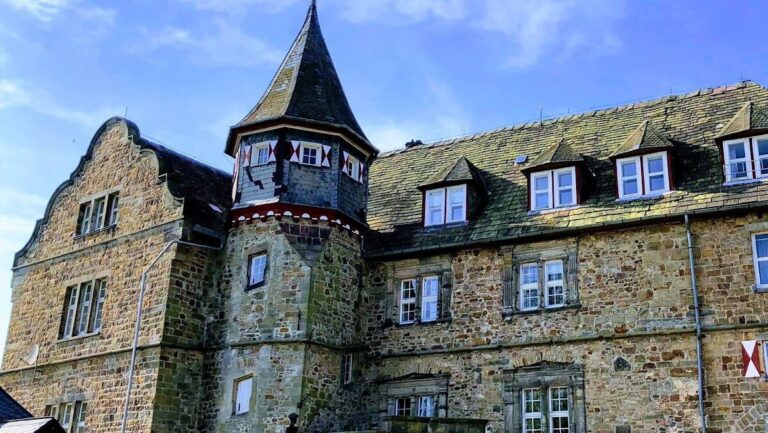Schloss Rodenberg: A Historic Water Castle in Germany
Visitor Information
Google Rating: 4.5
Popularity: Very Low
Google Maps: View on Google Maps
Country: Germany
Civilization: Unclassified
Remains: Military
History
Schloss Rodenberg is situated in the town of Rodenberg, Germany, and was originally built by the Lords of Schaumburg during the early 13th century. Its purpose was closely tied to the settlement of Rodenberg, which gained the status of a free town in 1250.
The castle first appears in historical records in 1317, with officials managing the site mentioned shortly thereafter in 1320. Between 1330 and 1348, Count Adolf VII of Schaumburg undertook significant renewal and strengthening of the castle and its surrounding outer bailey. By 1348, the castle served as Adolf VII’s residence, while the outer bailey functioned as the seat of the Schaumburg bailiff starting in 1337.
In the late 15th century, Otto III of Schaumburg added further fortifications, including a tower rondel on the northeast corner and sluice gates. Around 1510, Anton I of Schaumburg expanded defenses by building a heavily fortified bastion integrated into the outer wall.
The mid-16th century saw conflict when Brunswick forces besieged Schloss Rodenberg in 1553. Repairs were completed by Otto IV of Schaumburg in 1556, followed by a remodeling of the palas (main residential building) in the Weser Renaissance style between 1560 and 1565, led by architects Jakob Kölling and Heinrich Schrader.
During the tumultuous Thirty Years’ War in the early 17th century, control of the castle changed hands multiple times. In 1638, imperial troops successfully defended the fortress. The death of the last Schaumburg ruler in 1647 brought the castle under the control of Hesse-Kassel. After this, Schloss Rodenberg lost much of its political importance, as administrative functions moved to Rinteln.
Landgrave Wilhelm VI initiated restoration efforts in 1661 and 1662 for the castle buildings but ordered the removal of defensive structures, including wall towers, in 1663. The formerly fortified outer bailey was converted into a domain rather than a military installation.
By the late 18th century, only portions of the bastion, the northeastern tower rondel with its sluice, and fragments of another southwestern tower rondel remained. The early 19th century saw the castle moat filled in, though it was restored again in 1940.
A devastating fire in 1859 destroyed much of the castle complex. Afterward, all buildings except the Ständehaus—the former palas—were demolished. This surviving structure was subsequently used as a Catholic church from 1950 until 1975 before being transformed into a local history museum in 1981.
Between 2000 and 2004, archaeological excavations uncovered remains of key defensive features such as the bastion, tower rondel, and sluice gates. These were partly reconstructed and incorporated into an open-air museum inaugurated in 2005. Further geophysical surveys in 2016 revealed foundations of supplementary buildings including stables, storage facilities, a carriage shed, and the castle well. These findings support the understanding that the castle’s earliest construction occupied the island where the Ständehaus stands today.
Remains
Schloss Rodenberg was originally constructed as a water castle on an island surrounded by two bodies of water—the Rodenberger Aue and a mill ditch. This natural moat was crossed by a bridge, making the site accessible while providing a defensive barrier. The castle featured a nearly closed four-wing layout, anchored by a palas, now known as the Ständehaus, and a bergfried or keep, which no longer exists.
The surviving Ständehaus remains on an island encircled by a water-filled moat. Its exterior wall bears traces of a fireplace once connected to an adjacent now-demolished structure. Over time, the palas was reduced to a single story, a change still visible through a partially preserved attached stair tower.
Encircling the castle is a defensive wall approximately 24 meters at its base and standing about 4 meters tall. Inside this wall ran a water moat up to 30 meters wide. Defensive features included bastions and tower rondels—rounded towers strengthening the fortifications. Of these, two have been preserved below ground, while three have vanished as a result of historic stone removal.
Surrounding the wall was an outer ditch called the Butengraben, measuring up to 20 meters wide on three sides. Fed by the Rodenberger Aue, this ditch helped to enhance the castle’s defenses by controlling water flow. Two sluice gates connected to the bastion and the tower rondel allowed defenders to raise water levels as needed.
The bastion, constructed in the early 16th century, is a stout two-story structure measuring about 10 by 10 meters. Its lower floor contained a powder magazine housed within a casemate—a vaulted chamber incorporated into the thick wall. Eight cannon firing ports and a particular type of narrow firing slit known as a “hosenscharte” provided artillery coverage.
The tower rondel dates from around 1480 and has a diameter of nearly eight meters. Both the bastion and the tower rondel were partially reconstructed after archaeological excavation and covered with protective roofs to preserve them. They are enclosed by fencing to ensure safety.
The former outer bailey, which once lay to the south of the main castle, has been completely leveled. Nevertheless, in the 1960s, canal construction uncovered numerous foundations inconsistent with 18th-century maps, indicating a more complex past layout.
More recent geophysical investigations discovered subsurface remains of several castle-related buildings including stables, a granary, a carriage house, the foundations of the palas itself, and the well that supplied water to the castle.
Today, the open-air museum encompasses the restored bastion, tower rondel, and remaining castle wall, along with the Ständehaus. Together, these elements illuminate the castle’s historical footprint and architectural evolution, with informational displays providing context for visitors exploring the site.










